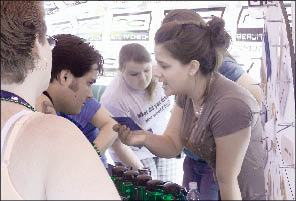 |
|
Youths at a music festival co-sponsored by Reality Check vie to answer a question about smoking as part of a contest. |
The American Legacy Foundation made approximately $126 million in grants from fiscal years 2000 to 2007, according to its tax returns. The largest chunk of those grants – $32.7 million – was made up of state empowerment grants, given to state health departments to develop efforts led by youth to educate their peers about the dangers of smoking and attempts by the tobacco industry to draw them in as new smokers.
[Related Story, The Truth About American Legacy]Those grants helped set up projects such as the New York Department of Health’s Reality Check. The department passes money to county-level Reality Check programs, and youth in those programs develop strategies to fight pro-smoking messaging from the tobacco industry. The Saratoga County club developed a “We Will Not Be Bought” campaign, handing out catchy T-shirts and key chains at local football games. In Clinton County, youth have hosted “Stomp” events, at which the club screens a movie and youth stomp their feet and cough whenever smoking scenes appear.
Other grantees of Legacy have included:
• HiTOPS – a New Jersey nonprofit that focuses on adolescent health and wellness and used Legacy grants to spread its smoking cessation program, said Executive Director Elizabeth Casparian. HiTOPS now runs the program through its general account, but might have to cut it if she can’t find new financial support, Casparian said.
• Emory University – started and continues to run the Tobacco Technical Assistance Consortium with funds from Legacy, the American Cancer Society and the Robert Wood Johnson Foundation.
• The Campaign for Tobacco-Free Kids –the most recognizable name in youth smoking prevention has received more than $11.3 million from the foundation since 2005.
Funding for state empowerment grants declined from a high of $10.1 million in 2002 to $64,000 in 2007, as Legacy has allocated more of its grants to programs that target ethnic populations (African-American, Native American, Hispanic and Asian), programs for gay youth, and technical assistance and training.
Legacy also increased its investment in research and evaluation over the years. Grants in that area totaled $1.3 million in 2000, but by 2007 Legacy had spent at least $27 million on research and evaluation grants.

























